Learning guitar chords can feel overwhelming at first. Many aspiring guitarists believe they need to memorize hundreds of chords individually. However, the secret to unlocking a vast chord vocabulary lies in understanding Chord Shapes Guitar. By learning a few fundamental shapes and how to move them around the fretboard, you’ll be able to play a multitude of chords with ease.
This guide will introduce you to 10 essential guitar chord shapes that are foundational for playing various genres and styles. Mastering these shapes will significantly accelerate your learning process and empower you to visualize chord progressions and changes across the neck. Instead of memorizing countless individual chords, you’ll learn the underlying patterns, making chord learning more efficient and intuitive.
Power Chords: The Foundation of Rock
Power chords are indispensable for rock, punk, and metal music. Their raw energy and simplicity make them incredibly versatile and easy to learn. A power chord, at its core, consists of only three notes: the root, the fifth, and the octave. This stripped-down structure gives power chords their signature powerful and open sound. The chord’s name is derived from its root note. For instance, if you play a power chord shape starting on the 5th fret of the low E string, you are playing an A power chord, often denoted as A5.
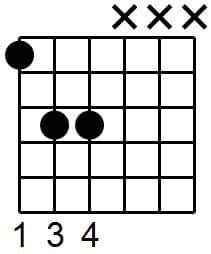 Power chord diagram showing A5 chord shape
Power chord diagram showing A5 chord shape
Image alt text: Power chord diagram illustrating the A5 chord shape on the guitar fretboard, highlighting the root note on the low E string.
You can easily adapt this power chord shape by moving it up and down the fretboard, changing the root note and thus the chord itself. Power chords are incredibly versatile because they are neither major nor minor, allowing them to fit seamlessly into both major and minor keys, making them a staple in countless rock anthems.
This shape can also be rooted on the A string for different voicings and tonal colours:
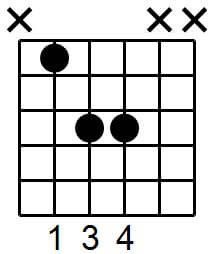 Power chord shape rooted on the A string
Power chord shape rooted on the A string
Image alt text: Guitar chord diagram showing a power chord shape rooted on the A string, demonstrating chord shape versatility.
And even on the D string, further expanding your sonic palette:
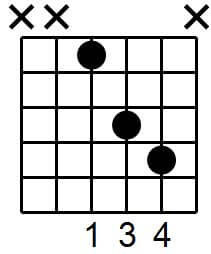 Power chord shape rooted on the D string
Power chord shape rooted on the D string
Image alt text: Power chord diagram illustrating a power chord shape with its root on the D string, showcasing fretboard adaptability.
6-String Major Barre Chords: Unlock Full Voiced Major Chords
Barre chords are often perceived as challenging for beginner guitarists, but mastering them is crucial for expanding your chord vocabulary and playing across the entire fretboard. A barre chord involves using your index finger to press down all six strings at a specific fret, creating a “barre” and forming the basis of the chord shape.
The 6-string major barre chord shape is fundamentally based on the open E major chord. If you form an E major chord using your second, third, and fourth fingers, you’ll notice your first finger is free. By moving this familiar E major shape up the guitar neck and using your first finger to barre across all six strings where the nut would be in the open E chord, you create a movable major barre chord shape.
Like power chords, barre chords take their name from the root note, which is the lowest note of the chord, played on the 6th string.
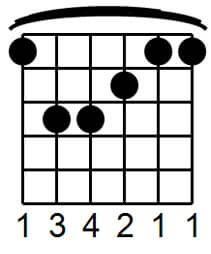 6-string major barre chord diagram based on E major shape
6-string major barre chord diagram based on E major shape
Image alt text: Diagram of a 6-string major barre chord shape on guitar, illustrating its origin from the open E major chord form.
6-String Minor Barre Chords: Transforming Major to Minor
The difference between a 6-string major barre chord and its minor counterpart lies in a single note: the major third. This note is played by your middle finger on the G string in the major barre chord shape. To convert a major barre chord to a minor barre chord, you need to “flatten” this major third, lowering it by a half step (one fret).
In the context of the barre chord shape, flattening the major third is already accomplished by the barre of your index finger! Therefore, to play a 6-string minor barre chord, simply remove your middle finger from the major barre chord shape. The resulting shape closely resembles the open E minor chord.
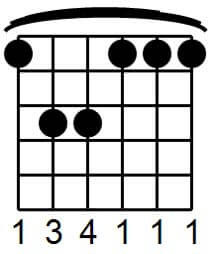 6-string minor barre chord diagram based on E minor shape
6-string minor barre chord diagram based on E minor shape
Image alt text: Guitar chord diagram showing the 6-string minor barre chord shape, derived from the E minor form by removing the middle finger from the major shape.
5-String Major Barre Chords: Rooted on the A String
Major barre chords can also be rooted on the A string (5th string), creating a different voicing and utilizing a chord shape based on the open A major chord. This 5-string major barre chord shape can be slightly trickier to fret cleanly initially, often requiring a bit more finger strength and precision.
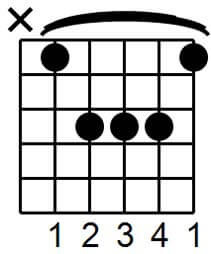 5-string major barre chord diagram based on A major shape
5-string major barre chord diagram based on A major shape
Image alt text: 5-string major barre chord shape diagram for guitar, demonstrating the A major based barre chord form.
5-String Minor Barre Chords: A Minor Variation on the A Shape
Just as with the 6-string barre chords, you can transform a 5-string major barre chord into a minor barre chord by altering the major third. In this 5-string shape, the major third is located on the B string (2nd string). To create a minor barre chord, you flatten this major third.
Similar to the 6-string minor conversion, the barre finger already covers the flattened third in the minor shape. The resulting 5-string minor barre chord shape bears a resemblance to the open A minor chord.
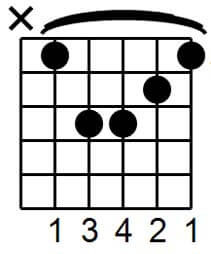 5-string minor barre chord diagram resembling A minor shape
5-string minor barre chord diagram resembling A minor shape
Image alt text: Guitar chord diagram illustrating the 5-string minor barre chord shape, which is similar to the open A minor chord form.
6-String Dominant 7 Chords: Adding Bluesy Flavor
Dominant 7 chords are excellent for injecting a bluesy or jazzy character into your chord progressions. The 6-string dominant 7 chord shape is derived from the 6-string major barre chord shape. To create a dominant 7th, you simply remove your little finger from the major barre chord shape. The note your little finger played was an octave of the root, which is less crucial in a 7th chord, allowing space for the characteristic b7 (flat 7th) interval to be added to the chord.
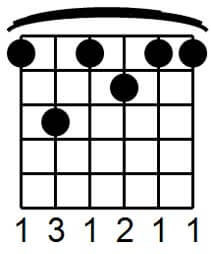 6-string dominant 7 chord diagram, major shape with little finger removed
6-string dominant 7 chord diagram, major shape with little finger removed
Image alt text: Diagram of a 6-string dominant 7 chord shape on guitar, showing the modification from the major barre chord by removing the little finger.
5-String Dominant 7 Chords: A-String Rooted 7th
Following the same principle as the 6-string version, the 5-string dominant 7 chord is created by modifying the 5-string major barre chord shape. You achieve this by flattening the major third. In this shape, the note to flatten is typically played by the middle finger.
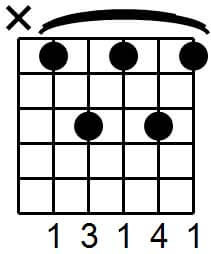 5-string dominant 7 chord diagram, A major shape with flattened third
5-string dominant 7 chord diagram, A major shape with flattened third
Image alt text: Guitar chord diagram of a 5-string dominant 7 chord shape, highlighting the flattened third modification from the A major barre chord.
6-String Minor 7 Chords: Melancholy and Smooth
While dominant 7 chords contain a major third, giving them a major quality in some contexts, you can transform them into minor 7 chords by flattening the major third. The 6-string minor 7 chord shape is built upon the 6-string dominant 7 shape. To create it, simply remove the middle finger, which was playing the major third on the G string in the dominant 7 shape.
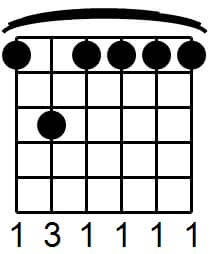 6-string minor 7 chord diagram, dominant 7 shape with middle finger removed
6-string minor 7 chord diagram, dominant 7 shape with middle finger removed
Image alt text: 6-string minor 7 chord shape diagram for guitar, illustrating the removal of the middle finger from the dominant 7 chord form.
5-String Minor 7 Chords: A Minor 7th Variation
The same principle of flattening the major third applies to the 5-string shapes. By flattening the major third in the 5-string dominant 7 shape, you arrive at the 5-string minor 7 chord shape.
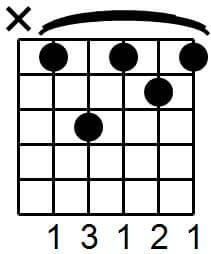 5-string minor 7 chord diagram, flattened major third from dominant 7
5-string minor 7 chord diagram, flattened major third from dominant 7
Image alt text: Guitar chord diagram showing the 5-string minor 7 chord shape, created by flattening the major third of the dominant 7 chord form.
7#9 Chords (The Hendrix Chord): Funky Blues and Rock
The final chord shape in this essential collection is the 7#9 chord, famously known as the “Hendrix chord” due to its prominent use by Jimi Hendrix. While labeled a 7 chord, it’s more accurately a re-voiced dominant 7 chord. You play the root on the A string, the major third on the D string, and the b7 on the G string. Notably, it omits the 5th from the major scale, which a full dominant 7 chord usually includes. The distinctive #9 note is played on the B string, adding a unique, dissonant, and funky flavor.
This chord is perfect for adding a bluesy and funky edge to your rhythm playing, and is a hallmark of Hendrix’s signature sound.
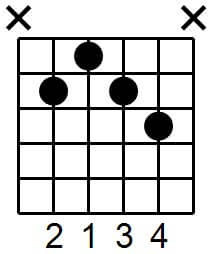 7#9 chord diagram, also known as the Hendrix chord
7#9 chord diagram, also known as the Hendrix chord
Image alt text: Guitar chord diagram of the 7#9 chord shape, often called the Hendrix chord, emphasizing its funky blues and rock sound.
Conclusion: Building Your Chord Vocabulary with Shapes
These 10 chord shapes are your starting point for building a comprehensive guitar chord vocabulary. By understanding these shapes and how they relate to major, minor, and dominant 7 chords, you’ll be able to play a vast array of chords across the fretboard. Practice these shapes in different keys and incorporate them into your playing to truly internalize them. Experiment with moving these shapes around the neck and listen to how the chord qualities change. With consistent practice, these chord shapes guitar will become second nature, unlocking new musical possibilities and making your guitar journey more rewarding.
